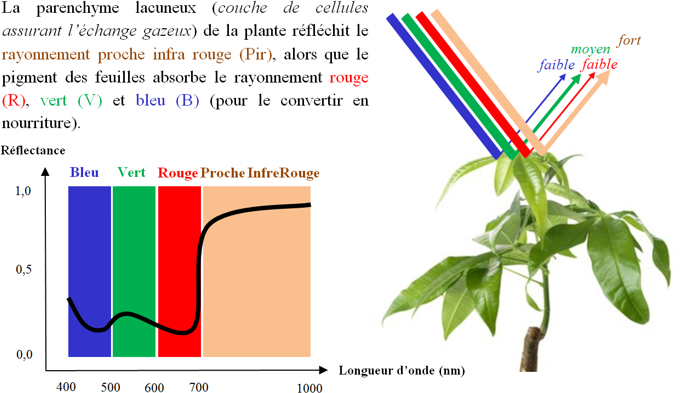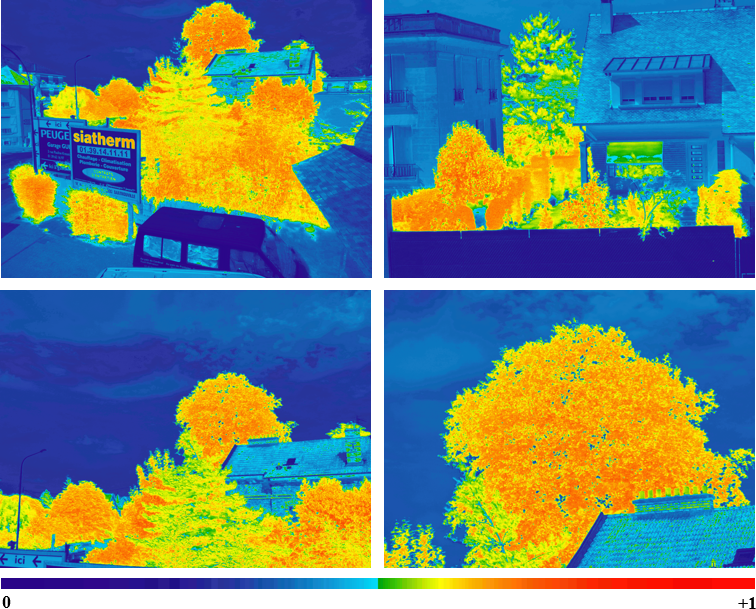This exploratory study aims to evaluate the interest and the limits of the characterization of the photosynthetic activity of plants within the framework of a project to assist in the diagnosis of urban trees. She is particularly interested in the evaluation of « low cost » devices
Spectral characteristics of vegetation
The anatomical structure of the leaves plays a very important role in the spectral signature of the vegetation. While chlorophyll pigments absorb most of the visible radiation that reaches them, they are completely transparent to longer wavelength radiation. The NIR thus passes through the sheet to a cellular layer in charge of gas exchanges with the atmosphere (lacunous parenchyma). It is at this layer, where oxygen and carbon dioxide exchange in photosynthesis and respiration processes, that near infrared radiation is strongly reflected.
Vegetation index
The standardized difference vegetation index (NDVI) assesses the plant’s ability to photosynthesize (or its photosynthetic activity). This is the difference between the intensities of the visible signal returned by the leaf surface and the near infrared signal returned by the defective parenchyma. It is typically used in remote sensing at the plot or landscape scale to map the stage of development or condition of crops.
Hybrid camera
The idea here is to use a modified digital camera to simultaneously capture the intensities in the visible spectrum and the near infrared spectrum. From a technical point of view, it is sufficient to replace the near infrared blocking filter (installed by default by the manufacturers to limit the intensity of radiation received by the sensor) by a blue or red blocking filter. For this experiment, we used a hybrid PowerShot SX280HS camera.
urban and near infrared tree : the near infrared signal is in the red channel of the image: the wavelengths corresponding to the red spectrum are ignored… The vegetation appears in red
The images present the expected properties in terms of color reproduction. We can thus work them, and notably calculate a vegetation index by standardized difference (NDVI) in which the visible component is represented by the Blue channel of the image (and not the Red channel as in the native definition of the index) and the near infrared component by the Red channel.
Overall, the vegetation index seems rather consistent with the content of the image: vehicles, buildings, urban furniture (excluding plants) present a negative response, plants a positive response. There are indeed some aberrations (text of the advertising panel in the top left image, reflection in the top right image window, chimney and tiles in the bottom images), relatively delicate to explain to date. There is good stability of response: few index variations between the upper left, lower left and lower right images (which represent the same scene at different magnifications).
The NDVI values are theoretically between -1 and +1, negative values corresponding to surfaces other than plant cover, such as snow, water or clouds, for which the reflectance in red is higher than that of the near infrared. For bare floors, the reflectances being about the same order of magnitude in red and near infrared, the NDVI has values close to 0. Plant formations, on the other hand, have positive NDVI values, generally between 0.1 and 0.7 – the highest values corresponding to the densest cover.
A sigmoid function is used to non-linearly associate NDVI values with scale colors to artificially increase the color dynamics of a given range of values (here, the range 0.2 to 0.7). The differences in plant areas (e.g., softwood vs. conifer response in the lower left image) are potentially more evident.
In absolute terms, this means applying the sigmoid function to the NDVI function to define a new index ranging from 0 to +1
Conclusion
This type of sensor is of undeniable interest (i) for hardwood/softwood discrimination and (ii) probably for the evaluation of the photosynthetic capacity of the tree, even if the use of the NDVI response requires additional studies.
Contact



